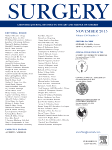 An investigation at St. Jude Children’s Hospital into “irregularities” in a figure featured in a neuroblastoma paper has concluded that the image was fabricated. The paper, published in Surgery in 2012, was retracted on Friday.
An investigation at St. Jude Children’s Hospital into “irregularities” in a figure featured in a neuroblastoma paper has concluded that the image was fabricated. The paper, published in Surgery in 2012, was retracted on Friday.
Here’s the full retraction notice for “Liposome-encapsulated curcumin suppresses neuroblastoma growth through nuclear factor-kappa B inhibition:”
This article has been retracted at the request of the Editors and Authors. The irregularities in Figure 3E have been investigated by the co-authors and St. Jude Children’s Research Hospital, and the investigation concluded that the image was fabricated. We therefore retract the publication. We apologize to the scientific community for any inconvenience resulting from the publication and retraction of this manuscript.
The paper — which presented the molecular underpinnings of how a form of curcumin could reduce the growth of neuroblastoma — has been cited 12 times, according to Thomson Scientific’s Web of Knowledge.
Michael Sarr at the Mayo Clinic, one of the editors of Surgery, declined to comment.
Last year, a commenter on PubPeer raised concerns over Figure 3E, the very image that the investigation determined was fabricated. The commenter points to other papers by last author Andrew Davidoff at St. Jude that have also been discussed on the site, such as a 2007 paper, this 2012 paper, and another 2013 paper in PLOS ONE.
We’ve contacted Davidoff and first author Wayne Orr, now at the University of Mississippi Medical Center. We’ve also asked representatives of St. Jude’s Children’s Hospital for more information about the investigation.
Like Retraction Watch? Consider making a tax-deductible contribution to support our growth. You can also follow us on Twitter, like us on Facebook, add us to your RSS reader, and sign up on our homepage for an email every time there’s a new post. Click here to review our Comments Policy.
Papers in Surgery under scrutiny at Pubpeer:-
https://pubpeer.com/publications/D53784B26C150A8C2E3ECCF8EBD974
https://pubpeer.com/publications/1062A559AFFE2992D93A2412DCE945
https://pubpeer.com/publications/67F00A871ABAE836F7B471C13203F9
https://pubpeer.com/publications/13E3CBB230FA49F4C1F5403DC6FB59
https://pubpeer.com/publications/F4DA1B693B9E55DE33782CBB42AFD6
Just out of curiosity (and I am sure I could find this out myself – just lazy :)) when did PubPeer start? I notice a lot of papers from 2012 or before being retracted for image duplication. I am just wondering if the advent of PubPeer (and hence a the start of images being scrutinised “en mass”) has reduced the number of researchers submitting manipulated images (in later publications)?
If so it should get a medal.